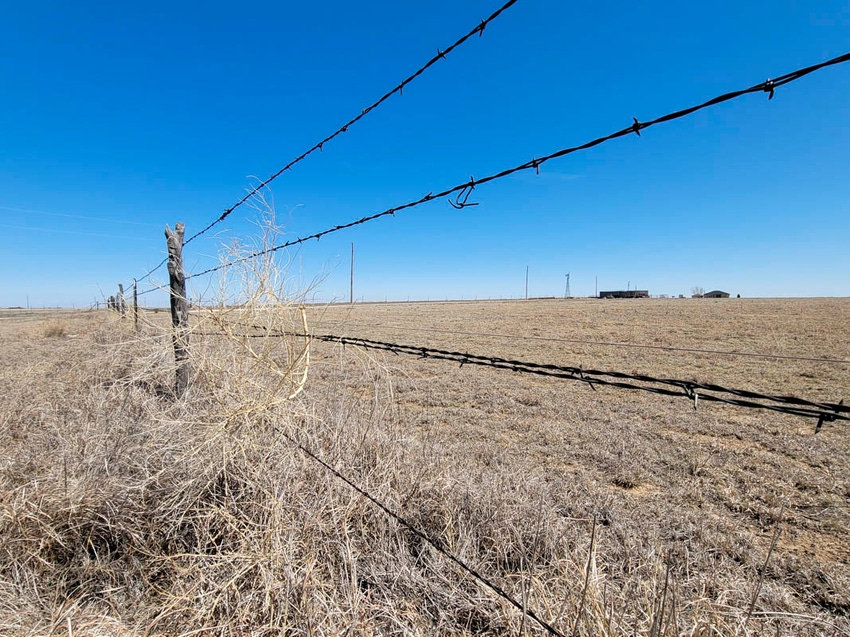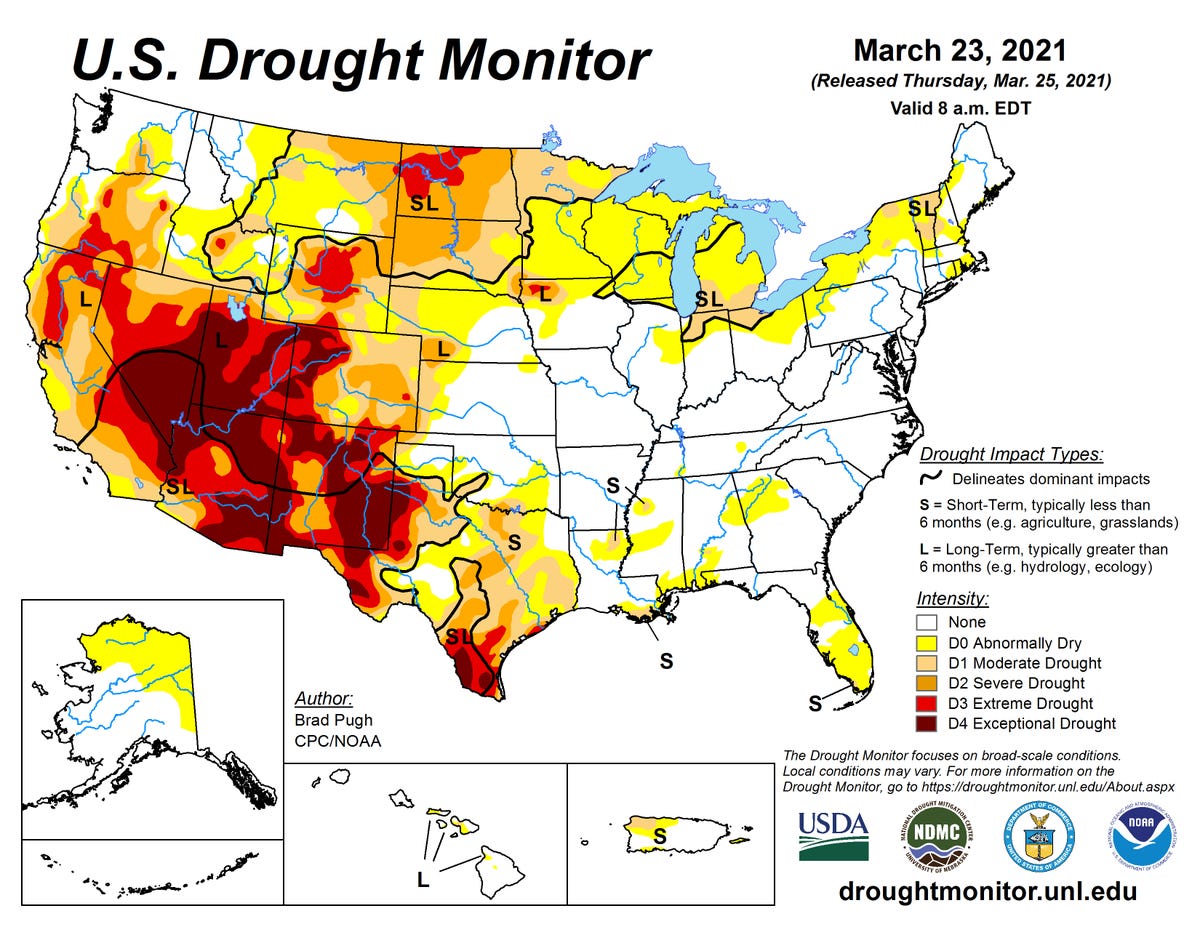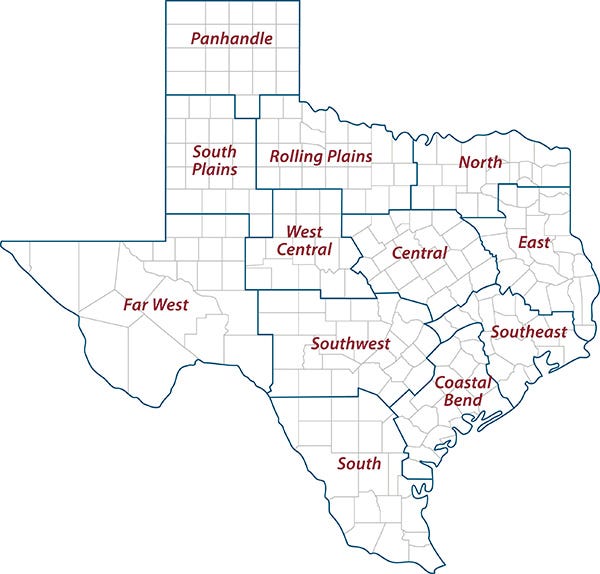
Parts of the state slipped deeper into drought, and farmers who depend on irrigation water may find supplies limited.
Parts of the state are in dire need of soil saturating rains and runoff to replenish reservoirs and aquifers as planting season nears, according to Texas A&M AgriLife Extension Service experts.

Row crop producers in drought-stricken parts of the state are pre-watering fields with the hope crops can establish and timely rains will improve growing conditions, according to AgriLife Extension agents and reports. But there are concerns that irrigation, and in some areas limited or restricted irrigation due to below-normal water levels, may not be enough.
Jourdan Bell, AgriLife Extension agronomist, Amarillo, said row crop producers are being very cautious about planting decisions on both irrigated and dryland acres. Higher prices for corn, sorghum and cotton are a plus, and spring snowfall and scant rains helped moisture levels some, but drought conditions leave tougher decisions ahead.
See photo gallery, Load'em up: From pasture to feedyard
“We ended 2020 with a moisture deficit, so in many areas we are starting 2021 from behind,” she said. “Corn, sorghum, and cotton prices are currently better than they have been in several years, but the drought and extended forecast may negatively impact planting decisions in parts of Texas, so many farmers may not benefit from the current strong markets.”
Soil moisture continues decline
A March 26 National Oceanic and Atmospheric Administration drought update for the U.S. Southern Plains, which includes Kansas, Oklahoma and Texas, showed drought conditions worsened in a large swath of the state. Western and southern parts Texas were experiencing extreme to exceptional drought, while drought conditions throughout Central Texas reached moderate to severe levels.
Conditions were not expected to improve by the time summer temperatures set in.
“Precipitation, temperature, and drought condition forecasts all suggest an expansion and intensification of drought conditions is likely over the next three months,” the report reads.
John Nielsen-Gammon, Texas state climatologist, Bryan-College Station, said a slight La Niña pattern, which typically delivers warmer, drier weather to Texas, is weakening and will probably become a neutral weather pattern by May. He too expects drier-than-normal conditions to continue and that arid conditions could exacerbate high summertime temperatures.
“We certainly expect warmer temperatures because of the drier conditions this winter,” he said. “There’s no swamp cooling effect that you get when there’s moisture in the soil and air.”
Water allotments to shrink
Dryland fields are at the mercy of Mother Nature, Bell said. Timely rains will be critical for dryland crop establishment and ultimate success or failure.
But Bell said drought conditions in the Panhandle will hit irrigated farmers harder than previous droughts. Producers no longer have the well capacity to compensate for increased temperatures and reduced precipitation because irrigation capacities decline with declining groundwater levels.
Similar irrigation shortages are brewing for other dry areas of Texas.
Orlando Flores, AgriLife Extension agriculture agent for El Paso County, said producers there are irrigating fields in preparation for planting but may have to adjust their irrigation according to water district restrictions. He noted water in that area could become limited due to supply rationing.
See, Workshop to assist livestock producers dealing with drought
West Texas is one of the driest parts of the state, and crops are irrigated via canals that feed from the Rio Grande River and Elephant Butte Reservoir to the north in New Mexico. A water-usage agreement provides regional agriculture – mostly Pima cotton, pecan orchards and alfalfa fields – allotted amounts of water each growing season based on available water levels.
Water levels in the Rio Grande River and Elephant Butte are below normal following long-term drought conditions throughout the river basins that feed them. And the Elephant Butte Irrigation District has projected slim water allotments for farmers.
“This year the allotment will be inches of water instead of feet,” he said. “Elephant Butte will get some runoff from snowpack and the water districts will determine irrigation availability. We go through this often, and producers will have to adjust, but if we can’t get water, we can’t get water.”
AgriLife Extension district reporters compiled the following summaries:

CENTRAL
No report.
ROLLING PLAINS
Daytime temperatures were above 70 degrees. Along with warmer weather, some areas in the district received up to 2.5 inches of beneficial rainfall. Moisture made a difference in rangeland, pasture and winter wheat conditions. Supplemental feeding continued in areas with limited grazing. Farmers were taking advantage of the recent moisture, preparing fields for the upcoming crop year by plowing and applying pre-emergent herbicides.
COASTAL BEND
Days were overcast, and light rainfall up to less than 1 inch were reported. Some areas remained in drought. Emerged corn and grain sorghum looked good. Nitrogen was being applied to some corn fields. Cotton planting progress was slow as producers were waiting for an improved soil moisture profile, but there was uncertainty about conditions improving before the planting window closes. Rice and soybean planting continued as soil temperatures warmed. Pasture green-up was sluggish due to lack of rain. Fertilizer and herbicide were applied to some hay fields. Cattle continued to find forage, and supplemental feeding slowed as producers rationed limited hay supplies. Low livestock ponds were still a concern. Calves were in fair to good condition and gaining weight. Cattle market prices remained strong.
EAST
Warm-season grasses were greening up and looked good. Warmer temperatures and spring rains helped. Most areas received some rainfall. Polk County reported soil moisture conditions were drying rapidly due to low humidity. Pasture and rangeland conditions were fair to good. Subsoil and topsoil conditions were adequate. Cherokee County reported two tornadoes caused damage to farms, homes and barns. Livestock were in fair to good condition with supplemental feeding taking place. Fly numbers increased. Feral hogs caused damage to pastures, hay meadows and other property.
SOUTH PLAINS
Several rain showers were reported across the district, with trace amounts up to 1.2 inches, but some counties did not receive any rain. Rains kept farmers out of fields in some areas but helped soil moisture levels. Other farmers were able to do some fieldwork. Cattle were in good condition.
PANHANDLE
Northern parts of the district reported adequate topsoil and short to adequate subsoil moisture. Soil moisture levels in south and central parts of the district were short to very short. Pasture and rangeland conditions were poor to fair. Winter wheat was responding to warmer weather but was in poor to good condition. Oat conditions were fair. Rain was needed.
NORTH
Topsoil moisture throughout the district was adequate to short. The past week was pleasant with daytime temperatures in the mid- to upper-70s. Significant storms passed through the district with counties reporting 1-5 inches of rainfall. Wheat was starting to grow with warmer weather and sunshine. Some fields were behind others but were recovering well. Ryegrass and clover were starting to grow in pastures. Early planted corn started to emerge. Livestock were in good condition. Cattle stopped eating hay and starting to seek green grass, so body condition scores dropped slightly. Calves were hitting the ground daily, which also contributed to lower body condition scores.
FAR WEST
Temperatures continued to fluctuate with evening temperatures in the low-30s to mid-40s, and daytime temperatures in the low-60s to mid-80s. Drought conditions continued to worsen with no precipitation reported. Grass fires consumed roughly 4,000 acres, but no livestock were lost. Irrigation sprinklers and pumps were shut down due to high winds. Farmers were preparing fields to begin planting cotton and peanuts. Winter wheat was in fair condition with very small heads emerging. Winter oats were left standing and will be grazed out. Several large cattle operations shipped large numbers of cattle. Working of early lambs and goats continued. Producers noted the percentage of lambs and goat kids lost during Winter Storm Uri were higher than originally thought. Producers continued to feed livestock and wildlife.
WEST CENTRAL
No report.
SOUTHEAST
Warm temperatures helped forage growth. Growing conditions were favorable with a few rain showers received. There were reports of up to 5 inches of rainfall in some areas. Rice continued to be planted. Some fields were being worked while others were still too wet to access. Rangeland and pasture ratings varied from excellent to very poor, with fair to good being the most common. Soil moisture levels throughout the district ranged from adequate to very short with adequate being the most common.
SOUTHWEST
Parts of the district received rainfall up to 0.73 inches. Pea to golf ball- size hail was reported, but there was no notable damage. Rangeland and pasture conditions continued to decline in drier areas. Kendall County reported herbicide treatments should begin soon. Spring wheat looked good, and corn planting was completed. Cotton planting should begin soon. Cattle markets seemed steady, and the sheep and goat markets remained high. Spring calving, lambing and kidding continued. Livestock conditions were fair to good, and supplemental feeding continued.
SOUTH
Soil moisture levels were short to very short, and drought conditions continued to worsen in most areas. Weather was mild with some areas reporting temperatures in the high 80s. It was windy and dry in most areas, and while some areas received light rains, there was nothing significant. Rains were in the forecast for some areas. All crops were under irrigation where available. Most plant life showed signs of moisture stress and had not rebounded from the winter storm. Pasture and rangeland continued to decline in most areas, and livestock supplemental feeding continued. Corn planting started in some areas and was wrapping up in others. Planted corn fields emerged. Sorghum planting was underway. Cotton planting was almost complete in southern parts of the district, and sesame planting was underway. Wheat and oat crops were in the soft-dough stage. Onions and sugarcane were being harvested. Producers were discing and ripping fields. Cowpeas were planted. Mesquite trees showed fresh growth. Hay producers cultivated fields and were waiting for rain to plant haygrazer. Hay prices increased to $65-$85 per bale. Some native grazing recovered well enough for cattle to feed on it, but many pastures were looking bare. Feed prices increased while cattle prices remained steady. Stock tanks were low. Producers in Zapata County continued to cull herds. Wildfire warnings increased.
Source: is AgriLife TODAY, which is solely responsible for the information provided and is wholly owned by the source. Informa Business Media and all its subsidiaries are not responsible for any of the content contained in this information asset.
Read more about:
DroughtAbout the Author(s)
You May Also Like




